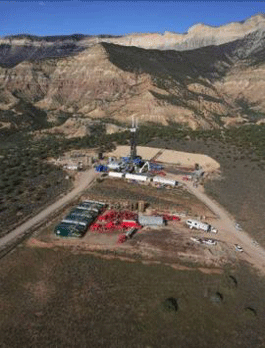Natural gas basics
What is natural gas?
Natural gas is a fossil energy source that formed deep beneath the earth's surface. Natural gas contains many different compounds. The largest component of natural gas is methane, a compound with one carbon atom and four hydrogen atoms (CH4). Natural gas also contains smaller amounts of natural gas liquids (NGLs; which are also hydrocarbon gas liquids), and nonhydrocarbon gases, such as carbon dioxide and water vapor. We use natural gas as a fuel and to make materials and chemicals.
How did natural gas form?
Millions to hundreds of millions of years ago and over long periods of time, the remains of plants and animals (such as diatoms) built up in thick layers on the earth’s surface and ocean floors, sometimes mixed with sand, silt, and calcium carbonate. Over time, these layers were buried under sand, silt, and rock. Pressure and heat changed some of this carbon and hydrogen-rich material into coal, some into oil (petroleum), and some into natural gas.
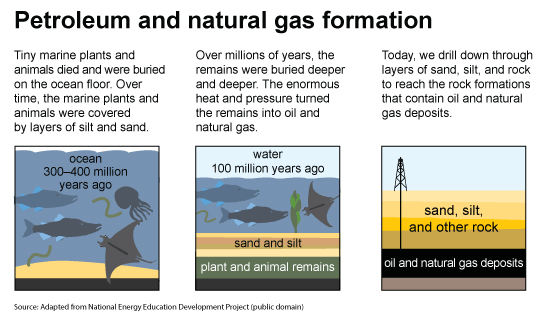
In some places, natural gas leaking into the air from cracks in the earth can be ignited by lightning or a fire. When people first saw this burning natural gas, they experimented with it and learned they could use it for heat and light.
Where is natural gas found?
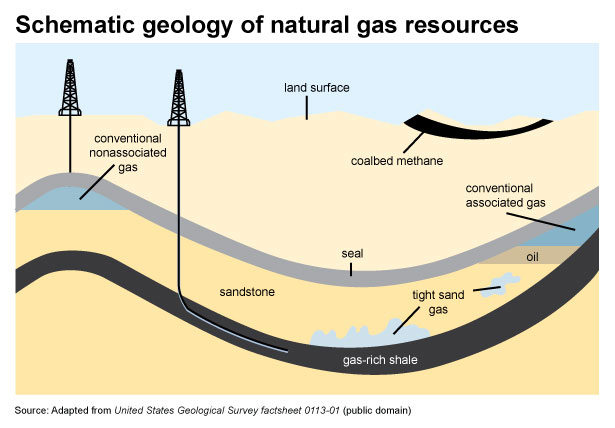
Source: Adapted from United States Geological Survey factsheet 0113-01 (public domain)
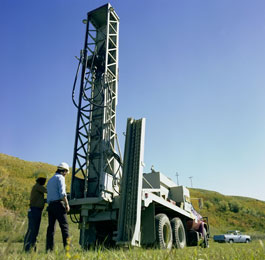
Source: Stock photography (copyrighted)
As natural gas formed over time, it moved into large cracks and spaces between layers of overlying rock. The natural gas found in these types of formations is sometimes called conventional natural gas. In other places, natural gas occurs in the tiny pores (spaces) within some formations of shale, sandstone, and other types of sedimentary rock. This natural gas is referred to as shale gas or tight gas, and it is sometimes called unconventional natural gas. Natural gas also occurs with deposits of crude oil, and this natural gas is called associated natural gas. Natural gas deposits are found on land and some are offshore and deep under the ocean floor. A type of natural gas found in coal deposits is called coalbed methane.
How do we find natural gas?
The search for natural gas begins with geologists who study the structure and processes of the earth. They locate the types of geologic formations that are likely to contain natural gas deposits.
Geologists often use seismic surveys on land and in the ocean to find the right places to drill natural gas and oil wells. Seismic surveys create and measure seismic waves in the earth to get information on the geology of rock formations. Seismic surveys on land may use a thumper truck, which has a vibrating pad that pounds the ground to create seismic waves in the underlying rock. Sometimes small amounts of explosives are used. Seismic surveys conducted in the ocean use blasts of sound that create sonic waves to explore the geology beneath the ocean floor.
If the results of seismic surveys show that a site has potential for producing natural gas, an exploratory well is drilled and tested. The results of the test provide information on the quality and quantity of natural gas in the resource.
Drilling natural gas wells and producing natural gas
If the results from a test well show that a geologic formation has enough natural gas to produce and make a profit, one or more production (or development) wells are drilled. Natural gas wells can be drilled vertically and horizontally into natural gas-bearing formations. In conventional natural gas deposits, the natural gas generally flows easily up through wells to the surface.
In the United States and in a few other countries, natural gas is produced from shale and other types of sedimentary rock formations by forcing water, chemicals, and sand down a well under high pressure. This process, called hydraulic fracturing or fracking, and sometimes referred to as unconventional production, breaks up the formation, releases the natural gas from the rock, and allows the natural gas to flow to and up wells to the surface. At the top of the well on the surface, natural gas is put into gathering pipelines and sent to natural gas processing plants.
Did you know?
Because natural gas is colorless, odorless, and tasteless, natural gas companies add mercaptan to natural gas to give it a distinct and unpleasant odor to help detect leaks in natural gas pipelines. Mercaptan is a harmless chemical that smells like rotten eggs.
Natural gas from natural gas or crude oil wells is treated at natural gas processing plants before it is put into natural gas pipelines.
In places where natural gas pipelines are not available to take away associated natural gas produced from oil wells, the natural gas may be reinjected into the oil-bearing formation, or it may be vented or burned (flared). Reinjecting this natural gas can help to maintain pressure in oil wells to improve oil production.
Coalbed methane can be extracted from coal deposits before or during coal mining, and it can be added to natural gas pipelines without any special treatment.
Getting natural gas to users
Delivery of natural gas to consumers
Delivering natural gas from natural gas and oil wells to consumers requires many infrastructure assets and processing steps, and it includes several physical transfers of custody.
Natural gas delivery infrastructure can be grouped into three categories:
- Processing
- Transportation
- Storage
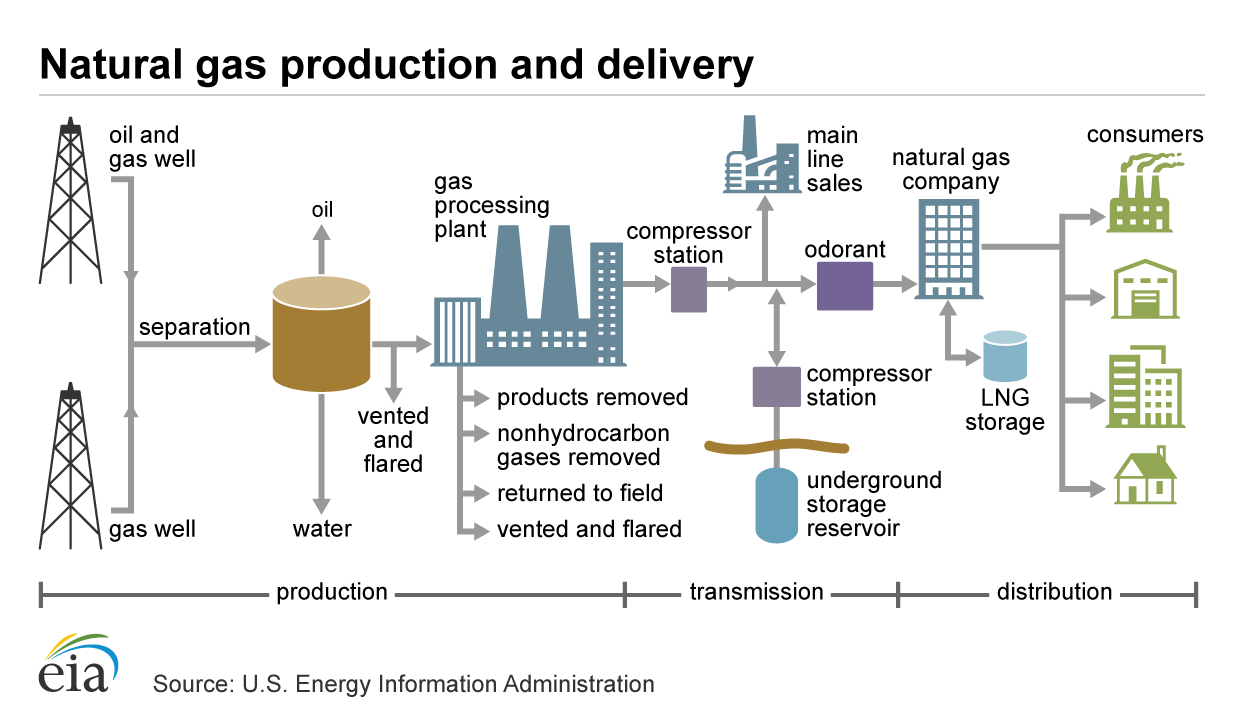
Processing natural gas for transportation by pipeline
Natural gas is transported from wells through gathering pipelines to natural gas processing plants where contaminants and hydrocarbon gas liquids (HGLs) are removed so dry natural gas can be safely delivered in high-pressure, long-distance pipelines to consumers.
Natural gas processing can be complex and usually involves several processes, or stages, to remove oil, water, HGLs, and other impurities such as sulfur, helium, nitrogen, hydrogen sulfide, and carbon dioxide. The composition of the wellhead natural gas determines the number of stages and the processes required to produce pipeline-quality dry natural gas. These stages and processes may be integrated into one unit or operation, be performed in a different order or at alternative locations (lease/plant), or not be required at all.
The basic stages of natural gas processing/treatment are
- Gas-oil-water separators: Pressure relief in a single-stage separator causes a natural separation of the liquids from the gases in the natural gas. In some cases, a multi-stage separation process is required to separate the different fluid streams.
- Condensate separator: Condensates are most often removed from the natural gas stream at the wellhead with separators much like gas-oil-water separators. The natural gas flow into the separator comes directly from the wellhead. Extracted condensate is sent to storage tanks.
- Dehydration: A dehydration process removes water that may cause the formation of undesirable hydrates and water condensation in pipelines.
- Contaminant removal: Nonhydrocarbon gases—such as hydrogen sulfide, carbon dioxide, water vapor, helium, nitrogen, and oxygen—must also be removed from the natural gas stream. The most common removal technique is to direct the natural gas though a vessel containing an amine solution. Amines absorb hydrogen sulfide and carbon dioxide from natural gas and can be recycled and regenerated for repeated use.
- Nitrogen extraction: Once the hydrogen sulfide and carbon dioxide are reduced to acceptable levels, the natural gas stream is routed to a Nitrogen Rejection Unit (NRU), where it is further dehydrated using molecular sieve beds.
- Methane separation: The process of demethanizing the natural gas stream can occur as a separate operation in a natural gas processing plant or as part of the NRU operation. Cryogenic processing and absorption methods are some of the ways used to separate methane from HGL.
- Fractionation: Fractionation separates the HGL into component liquids using the varying boiling points of the individual HGL. HGL from the processing plant may be sent to petrochemical plants, oil refineries, and other HGL consumers.
Pipelines move natural gas from production fields to markets
Natural gas transmission pipelines are wide-diameter pipelines and are often the long-distance portion of natural gas pipeline systems that connect gathering systems in producing areas, natural gas processing plants, other receipt points, and the main consumer service areas. There are three types of transmission pipelines:
- Interstate natural gas pipelines operate and transport natural gas across state borders.
- Intrastate natural gas pipelines operate and transport natural gas within a state border.
- Hinshaw natural gas pipelines receive natural gas from interstate pipelines and deliver it to consumers for consumption within a state border.
When natural gas arrives at the locations where it will be used (usually through large pipelines), it flows into smaller diameter pipelines called mains and then into smaller service lines that go directly to homes or buildings.
Natural gas can also be stored for times of peak demand
Demand for natural gas changes daily and seasonally, while production and pipeline imports are relatively constant in the short term. Storage of natural gas during periods of low demand helps to ensure that supplies of natural gas are available during periods of high demand. Natural gas is stored in large volumes in underground facilities and in smaller volumes in tanks above or below ground.
The United States uses three main types of natural gas underground storage facilities:
- Depleted natural gas or oil fields—that are close to consuming areas are where most of the natural gas is stored in the United States.
- Salt caverns—which provide high withdrawal and injection rates relative to their working natural gas capacity. Base natural gas requirements are relatively low. Most of the salt cavern storage facilities are in salt dome formations in the states bordering the Gulf of America. Salt caverns have also been leached from bedded salt formations in states in the Midwest, Northeast, and Southwest.
- Aquifers—that are converted to natural gas storage reservoirs, most notably in the Midwest, where water-bearing sedimentary rock formations are overlaid with impermeable cap rock.
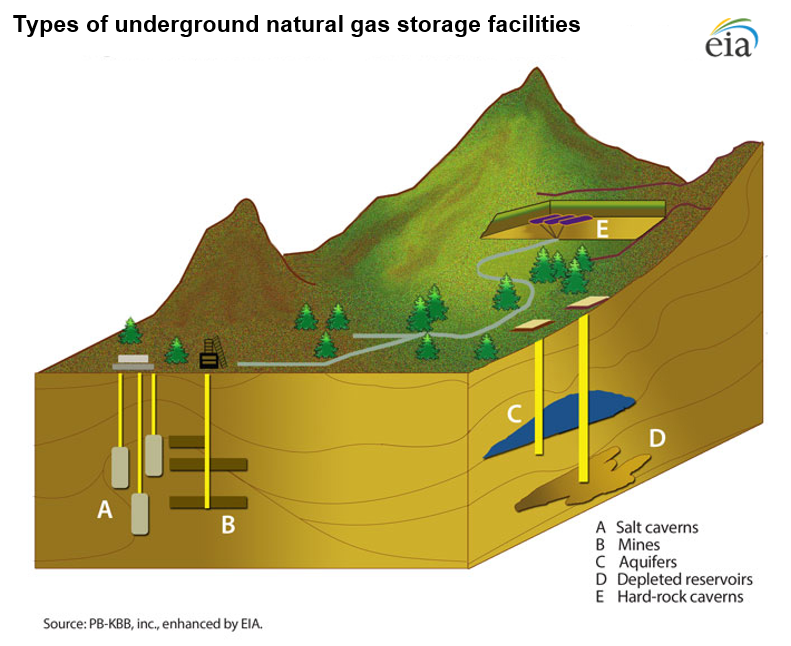
What is liquefied natural gas?
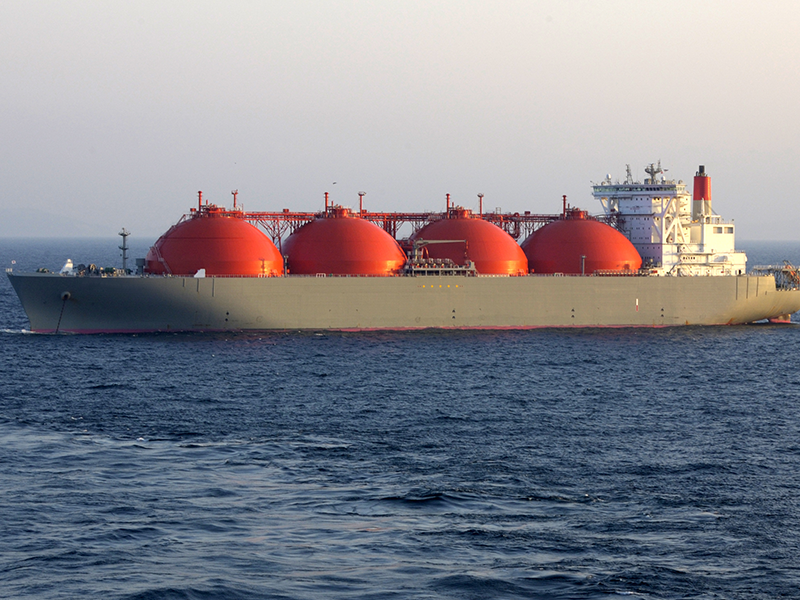
Source: Stock photo (copyrighted)
Liquefied natural gas (LNG) is natural gas that has been cooled to a liquid state, at about -260° Fahrenheit, for shipping and storage. The volume of natural gas in its liquid state is about 600 times smaller than its volume in its gaseous state in a natural gas pipeline. Natural gas liquefaction makes it possible to transport natural gas to places pipelines do not reach and to use natural gas as a transportation fuel.
LNG increases markets for natural gas
Where natural gas pipelines are not feasible or do not exist, liquefying natural gas is a way to move natural gas from where it is produced to where it is used, such as to and from the United States and other countries.
LNG export facilities receive natural gas from pipelines and liquefy the gas for transport on special ocean-going LNG ships or tankers. Most LNG is transported by tankers called LNG carriers in large, super-cooled (cryogenic) tanks. LNG is also transported in smaller containers that can be placed on ships and on trucks.
At import terminals, LNG is offloaded from ships and may be stored in cryogenic storage tanks before it is returned to its gaseous state or regasified. After regasification, the natural gas is transported in natural gas pipelines to natural gas-fired power plants, industrial facilities, and residential and commercial customers.
Did you know?
Natural gas is transported on specially designed ships as liquefied natural gas (LNG). LNG is natural gas that is cooled to -260° Fahrenheit, the temperature at which natural gas becomes a liquid. The volume of the liquid is 600 times smaller than the gaseous form.
U.S. LNG imports peaked in 2007
The United States imported very small amounts of LNG until 1995, and then LNG imports generally increased each year until peaking in 2007 at about 771 billion cubic feet (Bcf). LNG imports declined in most years since 2007 mainly because of as increases in U.S. natural gas production and expansion of the U.S. natural gas pipeline network reduced the need to import natural gas.
In 2021, the United States imported about 21.59 Bcf of LNG from just two countries. This was equal to about 1% of total U.S. natural gas imports in 2021.
- The source countries, amounts, and percentage shares of total LNG imports in 2021 were:
- Trinidad and Tobago 21.4223 Bcf 99.2%
- Canada 0.17 Bcf 0.8%
- Norway 3.03 Bcf 6.2%
- Canada 0.04 Bcf 0.1%
In 2021, U.S. LNG exports reached a record high of about 3,561 Bcf to 45 countries, and LNG exports accounted for 54% of total U.S. natural gas exports. About half of LNG exports went to five countries in 2021.
- The top five destination countries, amounts exported, and percentage shares of total U.S. LNG exports in 2021 were:
- South Korea 453.5 Bcf 12.7%
- China 449.7 Bcf 12.6%
- Japan 354.9 Bcf 10.0%
- Brazil 307.7 Bcf 8.4%
- Spain 215.1 Bcf 6.0%
Where our natural gas comes from
The United States now produces nearly all of the natural gas that it uses
U.S. dry natural gas production in 2020 was about 33.5 trillion cubic feet (Tcf), an average of about 91.5 billion cubic feet per day and the second-highest annual amount recorded. Most of the production increases since 2005 are the result of horizontal drilling and hydraulic fracturing techniques, notably in shale, sandstone, carbonate, and other tight geologic formations. Natural gas is produced from onshore and offshore natural gas and oil wells and from coal beds. In 2020, U.S. dry natural gas production was about 10% greater than U.S. total natural gas consumption.
Five of the 34 natural gas producing states accounted for about 69% of total U.S. dry natural gas production in 2020.
- The top five natural gas-producing states and their percentage shares of total U.S. natural gas production in 2020 were:
- Texas23.9%
- Pennsylvania21.1%
- Louisiana9.5%
- Oklahoma7.6%
- West Virginia7.1%
What is shale?
Shale is a sedimentary rock that formed over millions of years as layers of small rocks, silt, and clay were buried under other layers of rock. Some layers of shale and other types of rock also contain biomass material. Oil and natural gas formed from this material and was trapped in small pores in the rock. The trapped natural gas and oil can be extracted the rock layers using hydraulic fracturing or fracking. Most U.S. natural gas is now produced from shale and other tight rock formations.
Offshore natural gas production
Although most of the natural gas and oil wells in the United States are on land, some wells are drilled into the ocean floor in waters off the coast of the United States. Most of U.S. offshore natural gas production occurs in federal waters in the Gulf of America, the source of about 2% of U.S. dry natural gas production in 2020.
Coalbed methane and supplemental gaseous fuels
Coalbed methane, which is found in layers or beds of coal, is added to the U.S. natural gas supply. In 2019, U.S. coalbed methane production was equal to about 3% of total U.S. dry natural gas production.
Other sources of hydrocarbon gases that are included in U.S. natural gas production and consumption include blast furnace gas, refinery still gas, biomass gas, propane-air mixtures, and a gas made from petroleum or from coal called synthetic natural gas (natural gas made from petroleum hydrocarbons or from coal). These supplemental gaseous fuels were equal to about 0.2% of U.S. natural gas consumption in 2020. The largest source of synthetic natural gas in the United States is the Great Plains Synfuels Plant in Beulah, North Dakota, where coal is converted to pipeline-quality natural gas.
Natural gas imports and exports
Although most of the natural gas consumed in the United States is produced in the United States, the United States imports some natural gas to help supply U.S. demand. The United States also exports natural gas. Most natural gas imports and exports are by pipeline as a gas and by ship as LNG. Small amounts of natural gas are imported and exported by trucks as LNG and as compressed natural gas (CNG).
Most of U.S. natural gas imports are from Canada
In 2021, about 99% of U.S. total annual natural gas imports were from Canada and nearly all by pipelines. A small amount of CNG came by truck from Canada—0.01% of total natural gas imports. About 1% of total U.S. natural gas imports came as LNG, of which 99% were from Trinidad and Tobago. U.S. natural gas imports are generally highest in winter when imports help meet increases in natural gas demand for heating.
Did you know?
In 2021, U.S. natural gas exports reached a record high, and the United States was a net exporter of natural gas for the fifth year in a row.
Natural gas imports peaked in 2007
Total annual imports of natural gas generally declined since 2007, mainly because increases in U.S. natural gas production reduced the need for imports. Total annual imports peaked in 2007 at about 5 trillion cubic feet (Tcf). In 2021, total annual U.S. natural gas imports were 2.81 Tcf (7.29 Bcf/d).
Natural gas exports reached a record high in 2021
Until 2000, the United States exported small volumes of natural gas and mostly by pipeline to Mexico and Canada. In 2021, total annual U.S. natural gas exports were 6.65 Tcf—the highest on record, and the United States has been an annual net exporter of natural gas since 2017.
About 46% of the total U.S. natural gas exports in 2021 were by pipeline, of which 70% went to Mexico and 30% went to Canada.
Uses of natural gas
The United States consumed 32.50 trillion cubic feet (Tcf) of natural gas in 2023, the equivalent of about 33.61 quadrillion British thermal units (quads) and about 36% of U.S. primary energy consumption.
- Natural gas cosumption by sectors, amount and percentage share of total U.S. natural gas consumption in 2023 was:
- electric power12.93 Tcf40%
- industrial10.51 Tcf32%
- residential4.48 Tcf14%
- commercial3.31 Tcf10%
- transportation1.27 Tcf4%
How natural gas is used in the United States
Most U.S. natural gas use is for generating electricity and for space heating, but some consuming sectors have other uses for natural gas.
The electric power sector uses natural gas to generate electricity. In 2023, the electric power sector accounted for about 40% of total U.S. natural gas consumption, and about 42% of the U.S. electric power sector's primary energy consumption was natural gas. Most of the electricity produced by the electric power sector is sold to (purchased by) and used by the other U.S. consuming sectors—commercial, industrial, residential, and transportation. That electricity use is included in each sector’s total energy consumption. The other consuming sectors also use natural gas to generate electricity, and they use nearly all of this electricity themselves.
The industrial sector uses natural gas as a fuel for process heating, in combined heat and power systems, and as a raw material (feedstock) to produce chemicals, fertilizer, and hydrogen. In 2023, the industrial sector accounted for about 32% of total U.S. natural gas consumption, and about 42% of the U.S. industrial sector's total energy consumption was natural gas.
The residential sector uses natural gas for building and water heating, cooking, and clothes drying. About half of the homes in the United States use natural gas for these purposes. In 2023, the residential sector accounted for about 14% of total U.S. natural gas consumption, and about 41% of the U.S residential sector's total energy consumption was natural gas.
The commercial sector uses natural gas to heat commmercial buildings and water, to operate refrigeration and cooling equipment, cooking, drying clothes, and providing outdoor lighting. Some consumers in the commercial sector also use natural gas as a fuel in combined heat and power systems. In 2023, the commercial sector accounted for about 10% of total U.S. natural gas consumption, and about 37% of the commercial sector's total energy consumption was natural gas.
The transportation sector uses natural gas as a fuel to operate compressors that move natural gas through pipelines and as a vehicle fuel in the form of compressed natural gas and liquefied natural gas. Nearly all vehicles that use natural gas as a fuel are in government and private vehicle fleets. In 2023, the transportation sector accounted for about 4% of total U.S. natural gas consumption, and about 5% of the transportation sector's total energy consumption was natural gas. About 96% of the sector's natural gas consumption was used for natural gas pipeline and distribution operations.
Where natural gas is used
Natural gas is used throughout the United States, but five states accounted for about 39% of total U.S. natural gas consumption in 2023.
- The five top natural gas-consuming states and their percentage shares of total U.S. natural gas consumption in 2023:
- Texas15.7%
- California6.4%
- Louisiana6.1%
- Pennsylvania5.7%
- Florida5.0%
Natural gas and the environment
Natural gas has many qualities that make it an efficient, relatively clean burning, and economical energy source. However, the production and use of natural gas have some environmental and safety issues to consider.
Natural gas is a relatively clean burning fossil fuel
Burning natural gas for energy results in fewer emissions of nearly all types of air pollutants and carbon dioxide (CO2) than burning coal or petroleum products to produce an equal amount of energy. About 117 pounds of carbon dioxide are produced per million British thermal units (MMBtu) equivalent of natural gas compared with more than 200 pounds of CO2 per MMBtu of coal and more than 160 pounds per MMBtu of distillate fuel oil. The clean burning properties of natural gas have contributed to increased natural gas use for electricity generation and as a transportation fuel for fleet vehicles in the United States.
Natural gas is mainly methane—a strong greenhouse gas
Some natural gas leaks into the atmosphere from oil and natural gas wells, storage tanks, pipelines, and processing plants. The U.S. Environmental Protection Agency estimates that in 2019, methane emissions from natural gas and petroleum systems and from abandoned oil and natural gas wells were the source of about 29% of total U.S. methane emissions and about 3% of total U.S. greenhouse gas emissions (based on carbon-dioxide equivalent). The oil and natural gas industry takes steps to prevent natural gas leaks.
Natural gas exploration, drilling, and production affects the environment
When geologists explore for natural gas deposits on land, they may disturb vegetation and soil with their vehicles. Drilling a natural gas well on land may require clearing and leveling an area around the well site. Well drilling activities produce air pollution and may disturb people, wildlife, and water resources. Laying pipelines that transport natural gas from wells usually requires clearing land to bury the pipe. Natural gas production can also produce large volumes of contaminated water. This water requires proper handling, storage, and treatment so that it does not pollute land and other waters. Natural gas wells and pipelines often have engines to run equipment and compressors, which produce air pollutants and noise.
In areas where natural gas is produced at oil wells but is not economical to transport for sale or contains high concentrations of hydrogen sulfide (a toxic gas), it is burned (flared) at well sites. Natural gas flaring produces CO2, carbon monoxide, sulfur dioxide, nitrogen oxides, and many other compounds, depending on the chemical composition of the natural gas and on how well the natural gas burns in the flare. However, flaring is safer than releasing natural gas into the air and results in lower overall greenhouse gas emissions because CO2 is not as strong a greenhouse gas as methane.
Did you know?
Advanced technologies like satellites, global positioning systems, remote sensing devices, and 3-D and 4-D seismic technologies make it possible to discover natural gas reserves while drilling fewer wells.
Advances in drilling and production technologies have positive and negative effects on the environment
New drilling and natural gas recovery technologies reduce the land area that is disturbed to develop oil and gas resources. Horizontal and directional drilling techniques make it possible to produce more natural gas from a single well than in the past, so fewer wells are needed to develop a natural gas field.
Hydraulic fracturing (commonly called hydrofracking, fracking, or fracing) of shale, sandstone, and carbonate rock formations is opening up large reserves of natural gas that were previously too expensive to develop. Fracking involves pumping liquids under high pressure into a well to fracture the rock, which allows natural gas to escape from the rock. Producing natural gas with this method has some effects on the environment:
- The fracturing of wells requires large amounts of water. In some areas of the country, significant use of water for fracking may affect aquatic habitats and the availability of water for other uses.
- If mismanaged, hydraulic fracturing fluid—which may contain potentially hazardous chemicals—could be released through spills, leaks, faulty well construction, or other exposure pathways. These releases could pollute surrounding areas.
- Hydraulic fracturing produces large amounts of wastewater at the surface, which may contain dissolved chemicals and other contaminants that require proper treatment before disposal or reuse.
- According to the U.S. Geological Survey, hydraulic fracturing "...causes small earthquakes, but they are almost always too small to be a safety concern. In addition to natural gas, fracking fluids and formation waters are returned to the surface. These wastewaters are frequently disposed of by injection into deep wells. The injection of wastewater into the subsurface can cause earthquakes that are large enough to be felt and may cause damage."
- Natural gas could be released to the atmosphere during and after well drilling, and the amount of these releases are under investigation.
Natural gas production, transportation, distribution, and storage require strict safety regulations and standards
Because a natural gas leak could cause an explosion, there are strict government regulations and industry standards to ensure the safe transportation, storage, distribution, and use of natural gas. Because processed natural gas has no odor, natural gas companies add a strong, rotten egg-like smelling substance called mercaptan to natural gas so that people can smell leaks.


